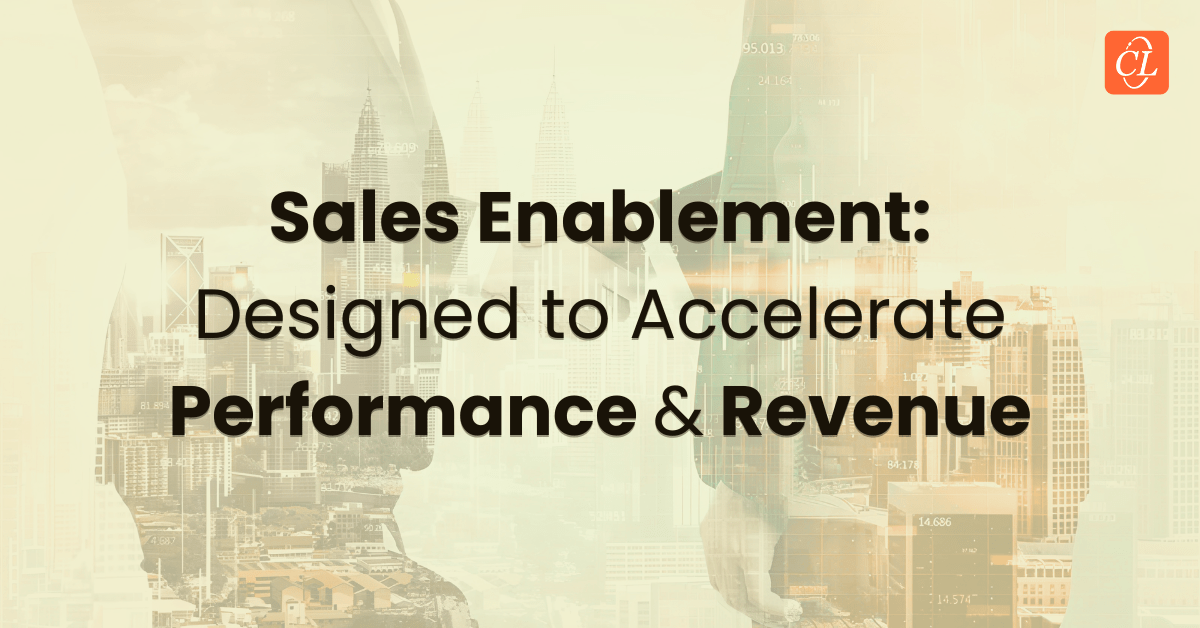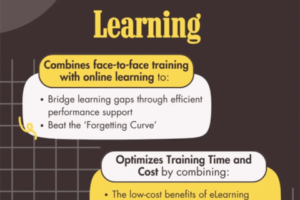
Sales Enablement Training: Driving Revenue Through L&D
Sales have never stood still and in 2025, the pace of change is dizzying. Buyers are more informed, digital channels dominate first impressions, and competition can feel one click away. In this environment, sales enablement has emerged as the discipline that keeps sales teams not just afloat, but ahead.
For Learning and Development (L&D) leaders, this shift changes the game. Sales enablement is no longer just about handing over product sheets or running onboarding sessions, it’s about creating a continuous learning ecosystem. From personalized training to real-time coaching and AI-driven insights, sales enablement equips sales professionals with the knowledge, skills, and tools they need to connect meaningfully with modern buyers.
The big question is: what does effective sales enablement look like in 2025, and how can L&D play a leading role in making it work?
Download eBook: An L&D Manager’s Implementation Guide
Table Of Content
What is Sales Enablement?
Sales enablement is the strategic process of providing sales teams with the training, content, tools, and coaching they need to boost performance and accelerate revenue growth. It aligns learning and resources with business objectives to ensure consistent, measurable sales success.
Unlike traditional sales training, which often happens in isolated sessions, sales enablement is ongoing and embedded into daily workflows. It ensures that salespeople have access to what they need exactly when they need it, whether that’s a quick refresher on handling objections, a personalized pitch deck, or an AI-driven insight about a prospect’s intent.
For L&D leaders, sales enablement is essentially the bridge between learning and revenue performance. It connects the instructional design of programs with measurable business outcomes such as:
- Shorter ramp-up time for new hires
- Higher win rates due to relevant and consistent messaging
- Improved buyer experiences through well-prepared and confident reps
- Stronger collaboration between sales, marketing, and L&D
In short, sales enablement transforms training from a one-time event into a strategic, data-driven ecosystem that makes learning practical, contextual, and performance-oriented.

How is AI Reshaping Sales Enablement in 2025?
AI in sales enablement refers to the use of intelligent technologies to automate routine tasks, deliver real-time coaching, and personalize learning for sales teams. It shifts enablement from static training events to adaptive, data-driven experiences that improve both seller performance and buyer engagement.
Sales Teams Using AI 1.3x More Likely to See Revenue Increase. Why? Because AI handles repetitive and time-consuming tasks, freeing salespeople to focus on higher-value conversations. But beyond productivity, AI is reshaping how sales training and coaching happen every day.
Here’s what that looks like in practice:
- Predictive coaching and deal insights: AI surfaces risks in the pipeline before they derail deals, giving managers data to target coaching where it matters most.
- Real-time feedback during calls: AI-enabled tools analyze tone, pacing, and language in live conversations, coaching sales professionals in the moment, not after the fact.
- Smarter learning in the flow of work: Instead of static playbooks, AI systems recommend the right training snippet, case study, or objection-handling guide based on the buyer, the deal stage, and the context.
- Automated admin and prep: From call summaries to CRM updates, AI assistants save sellers hours per week, time that can be reinvested in practice, coaching, or customer conversations.
For L&D leaders, the opportunity lies in embedding AI into training design. Imagine onboarding that uses AI role-plays for objection handling, or microlearning paths customized by individual performance data. This isn’t just faster learning; it’s smarter learning that directly ties to revenue outcomes.
What Tools Power Effective Sales Enablement Training in 2025?
Sales enablement tools are the platforms and technologies that deliver training, content, coaching, and analytics in an integrated way. In 2025, they form the foundation of enablement by embedding learning directly into sales workflows to drive measurable performance.
Here are the essential categories and examples of tools driving sales enablement training today:
- CRM as the command center – Tools like Salesforce and HubSpot go beyond tracking opportunities. When linked with enablement platforms, they can trigger contextual training prompts, such as surfacing an objection-handling guide or a microlearning module when a deal reaches a critical stage.
Watch how L&D leaders can use sales enablement strategies to drive real results.
- Enablement platforms – Solutions such as Highspot, Seismic, and Showpad centralize sales resources and training material in one hub. This ensures sales professionals don’t just download a pitch deck—they also access best-practice videos, playbooks, and case studies that show how to use it effectively.
- Conversation intelligence – Platforms like Gong and Chorus are doubling as training engines. They analyze live calls, flag coachable moments, and provide post-call transcripts with insights on tone, pacing, and buyer reactions. L&D teams can use this data to design realistic scenario-based learning activities and simulations.
- Learning management and microlearning systems – Tools such as Allego, EdApp, or corporate LMS platforms integrate seamlessly into daily workflows. They deliver bite-sized lessons, quizzes, and reinforcement activities that ensure skills are practiced and retained, not forgotten after onboarding.
- AI-powered assistants – Solutions like ChatGPT Enterprise, Outreach Kaia, and Zoom AI Companion take training further by offering real-time support: auto-generated call prep, personalized coaching tips, or adaptive learning paths based on each seller’s performance.
Key takeaway: In 2025, the most powerful sales enablement training tools are those that combine content, coaching, analytics, and AI into a seamless workflow. The goal is not just better sales execution, it’s a continuous learning loop that keeps sales teams sharp, confident, and buyer ready.
Which Metrics Actually Prove Sales Enablement’s Impact?
How Can L&D Maximize Sales Enablement ROI?
Here are the strategies L&D leaders can apply
- Target high-value segments: Focus efforts where returns are greatest.
- Audit & update content: Retire outdated assets to cut waste.
- Unify sales & marketing data: Align insights for sharper training.
- Design for scale: Build modular, reusable learning assets.
- Capture real feedback: Use employee and buyer input to refine.
- Prove cost-to-impact: Show ROI in dollars saved or gained.
Sales enablement metrics are the measurable indicators that connect training and enablement activities to business outcomes. They move beyond tracking participation (like content views) to proving how enablement drives sales performance and revenue growth.
Here are the four-core metrics that matter most:
- Win rate & deal velocity: Training programs that emphasize discovery, objection handling, and value articulation should result in higher close rates and faster deal cycles. Dashboards today can connect coaching completions or content usage directly to opportunity outcomes, helping leaders identify which learning interventions consistently move deals forward.
- Ramp time: Time-to-productivity is one of the clearest indicators of enablement success. Structured onboarding with 30–60–90-day milestones, simulations, and role-plays doesn’t just check a box, it accelerates a seller’s first quota attainment. By tracking ramp time, L&D leaders can demonstrate how training translates into faster contributions to revenue.
- Average deal size: Enablement isn’t only about closing more deals—it’s about closing better deals. Training that reinforces value-based selling and consultative conversations should correlate with larger contracts and more cross-sell/upsell opportunities. By analyzing call data and sales behaviors, organizations can link value-selling techniques directly to growth in average deal size.
- Sales productivity: AI-powered tools have introduced a new layer of measurement. By automating tasks like notetaking, research, and follow-ups, sales professionals spend more time selling. L&D teams can track this shift by measuring time saved on admin work versus time invested in customer conversations and link it back to training on how to best use these AI tools.
Industry research shows a clear shift toward data-driven enablement. Modern platforms now connect activities (training completions, coaching sessions, content usage) to outcomes (win rate, deal size, velocity). They also use these insights to personalize coaching paths, ensuring that every sales professional gets the support they need based on their own performance patterns.

What Challenges Can Derail Sales Enablement Training?
Sales enablement training challenges are the financial, technical, and organizational barriers that prevent programs from translating into real sales performance. They weaken ROI, slow adoption, and reduce leadership confidence in enablement as a growth driver.
Here are the toughest issues organizations are up against:
- Proving ROI under shrinking budgets CFOs want hard evidence that enablement is tied to revenue. Generic satisfaction scores or completion rates don’t cut it. Without clear metrics like ramp time reduction, deal velocity improvements, or win rate growth, enablement training risks being the first expense cut when budgets tighten.

An L&D Manager’s Guide to Successful Planning & Implementation.
Learn:
- What Challenges do L&D Managers Face?
- How to Align Business and Project?
- How to be a Learning Consultancy?
- DOWNLOAD NOW!
- The cost of fragmented tech stacks Many companies are paying for overlapping platforms—CRMs, Learning Management Systems, content hubs, coaching tools—that don’t integrate. Beyond subscription costs, this creates wasted time, data silos, and user fatigue. The challenge is rationalizing the tech stack, so every tool directly supports training impact and is adopted by sellers.
- Keeping pace with technical complexity Products are evolving faster, sales cycles are getting more complex, and buyers expect deep expertise. Traditional onboarding can’t keep up. The challenge for L&D is building just-in-time Custom training ecosystems that update in sync with product releases and market shifts, without blowing up timelines or budgets.
Explore CommLab India’s solutions that empower sales conversations—showcasing training that is personalized, engaging, and built for measurable impact.
- AI adoption without clear ROI AI promises real-time coaching, predictive insights, and admin relief. But leadership quickly asks: What’s the ROI? Without proof that AI-enabled training is shortening sales cycles or improving deal quality, investments are questioned. The challenge is not just piloting AI tools but tying their usage directly to measurable business outcomes.
- Manager accountability gap Enablement often fails because frontline managers aren’t reinforcing training. They’re pressed for time and lack the skills to coach effectively. This creates a leak in the ROI pipeline—millions spent on programs with little impact in the field. Closing this gap requires equipping managers with tools, dashboards, and incentives to make coaching non-negotiable.
Next Steps
To deliver real sales enablement training in 2025, L&D leaders must stop chasing checkboxes and start driving outcomes. The metrics that matter—ramp time, win rate, and deal size—should be front and center in all training design. Simultaneously, tool stacks must be streamlined so that every platform supports measurable behavior change, not user frustration. Training isn’t effective when it’s disconnected, but when it’s embedded, personalized, and reinforced in the flow of daily work.
Budget pressures and leadership scrutiny demand that every investment in enablement earns its keep. To stand firm, you need programs that validate ROI through hard numbers and continually adapt. That means designing learning paths that respond in near-real time to what the market, technology, and internal performance data are telling you. Managers must act not as passive overseers but as active coaches, reinforcing training, intervening early, and driving accountability to ensure learning turns into performance.
This eBook mentions that effective L&D planning is the real differentiator. By recognizing the challenges managers face, aligning training needs with business goals, and building clear strategies to achieve them, L&D leaders can transform enablement into a strategic advantage. Download now!






